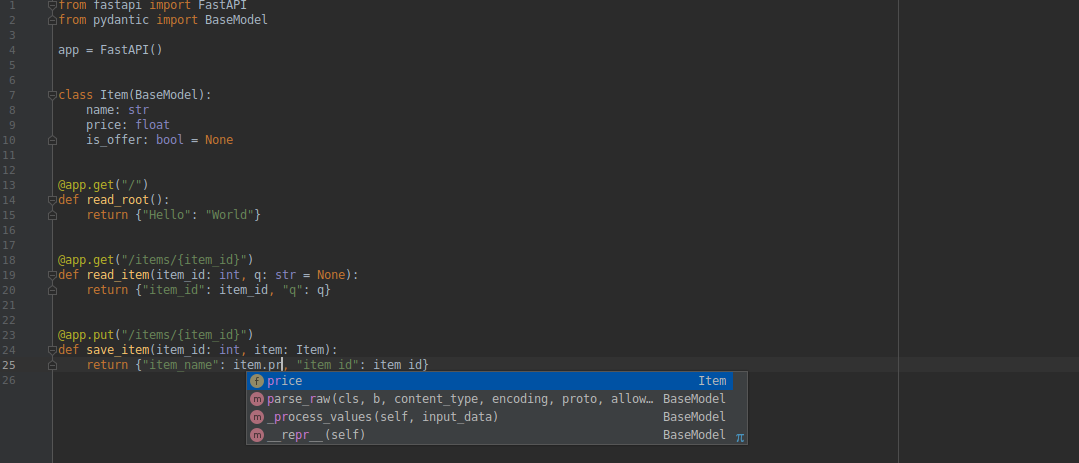- Sort Score
- Result 10 results
- Languages All
Results 91 - 100 of 132 for could (0.2 sec)
-
docs/en/docs/advanced/additional-status-codes.md
Plain Text - Registered: Sun May 05 07:19:11 GMT 2024 - Last Modified: Tue Oct 17 05:59:11 GMT 2023 - 2.6K bytes - Viewed (0) -
docs/en/docs/tutorial/schema-extra-example.md
In Pydantic version 1, you would use an internal class `Config` and `schema_extra`, as described in <a href="https://docs.pydantic.dev/1.10/usage/schema/#schema-customization" class="external-link" target="_blank">Pydantic's docs: Schema customization</a>. You can set `schema_extra` with a `dict` containing any additional data you would like to show up in the generated JSON Schema, including `examples`. !!! tipPlain Text - Registered: Sun May 05 07:19:11 GMT 2024 - Last Modified: Thu Apr 18 19:53:19 GMT 2024 - 11.8K bytes - Viewed (0) -
docs/en/docs/tutorial/dependencies/classes-as-dependencies.md
fluffy = Cat(name="Mr Fluffy") ``` In this case, `fluffy` is an instance of the class `Cat`. And to create `fluffy`, you are "calling" `Cat`. So, a Python class is also a **callable**. Then, in **FastAPI**, you could use a Python class as a dependency. What FastAPI actually checks is that it is a "callable" (function, class or anything else) and the parameters defined.
Plain Text - Registered: Sun May 05 07:19:11 GMT 2024 - Last Modified: Thu Apr 18 19:53:19 GMT 2024 - 11.4K bytes - Viewed (0) -
docs_src/security/tutorial004_an_py39.py
return encoded_jwt async def get_current_user(token: Annotated[str, Depends(oauth2_scheme)]): credentials_exception = HTTPException( status_code=status.HTTP_401_UNAUTHORIZED, detail="Could not validate credentials", headers={"WWW-Authenticate": "Bearer"}, ) try: payload = jwt.decode(token, SECRET_KEY, algorithms=[ALGORITHM]) username: str = payload.get("sub")
Python - Registered: Sun May 05 07:19:11 GMT 2024 - Last Modified: Tue Mar 26 16:56:53 GMT 2024 - 4.1K bytes - Viewed (0) -
docs_src/security/tutorial004_py310.py
return encoded_jwt async def get_current_user(token: str = Depends(oauth2_scheme)): credentials_exception = HTTPException( status_code=status.HTTP_401_UNAUTHORIZED, detail="Could not validate credentials", headers={"WWW-Authenticate": "Bearer"}, ) try: payload = jwt.decode(token, SECRET_KEY, algorithms=[ALGORITHM]) username: str = payload.get("sub")
Python - Registered: Sun May 05 07:19:11 GMT 2024 - Last Modified: Tue Mar 26 16:56:53 GMT 2024 - 4K bytes - Viewed (0) -
docs/en/docs/tutorial/cors.md
Plain Text - Registered: Sun May 05 07:19:11 GMT 2024 - Last Modified: Sun Nov 13 20:28:37 GMT 2022 - 5.1K bytes - Viewed (0) -
docs_src/security/tutorial005_an_py39.py
else: authenticate_value = "Bearer" credentials_exception = HTTPException( status_code=status.HTTP_401_UNAUTHORIZED, detail="Could not validate credentials", headers={"WWW-Authenticate": authenticate_value}, ) try: payload = jwt.decode(token, SECRET_KEY, algorithms=[ALGORITHM]) username: str = payload.get("sub")Python - Registered: Sun May 05 07:19:11 GMT 2024 - Last Modified: Tue Mar 26 16:56:53 GMT 2024 - 5.2K bytes - Viewed (0) -
docs_src/security/tutorial005_py39.py
else: authenticate_value = "Bearer" credentials_exception = HTTPException( status_code=status.HTTP_401_UNAUTHORIZED, detail="Could not validate credentials", headers={"WWW-Authenticate": authenticate_value}, ) try: payload = jwt.decode(token, SECRET_KEY, algorithms=[ALGORITHM]) username: str = payload.get("sub")Python - Registered: Sun May 05 07:19:11 GMT 2024 - Last Modified: Tue Mar 26 16:56:53 GMT 2024 - 5.1K bytes - Viewed (0) -
docs_src/security/tutorial005.py
else: authenticate_value = "Bearer" credentials_exception = HTTPException( status_code=status.HTTP_401_UNAUTHORIZED, detail="Could not validate credentials", headers={"WWW-Authenticate": authenticate_value}, ) try: payload = jwt.decode(token, SECRET_KEY, algorithms=[ALGORITHM]) username: str = payload.get("sub")Python - Registered: Sun May 05 07:19:11 GMT 2024 - Last Modified: Tue Mar 26 16:56:53 GMT 2024 - 5.1K bytes - Viewed (0) -
docs/en/docs/features.md
 You will get completion in code you might even consider impossible before. As for example, the `price` key inside a JSON body (that could have been nested) that comes from a request. No more typing the wrong key names, coming back and forth between docs, or scrolling up and down to find if you finally used `username` or `user_name`. ### Short
Plain Text - Registered: Sun May 05 07:19:11 GMT 2024 - Last Modified: Thu May 02 22:37:31 GMT 2024 - 9.3K bytes - Viewed (0)